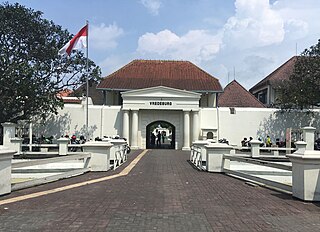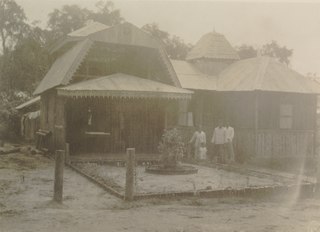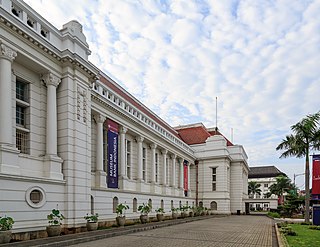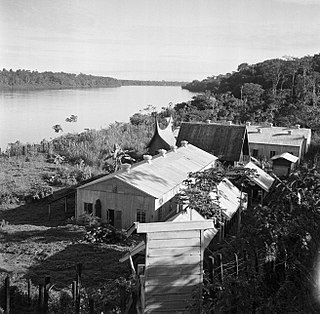
Fort van den Bosch, locally known as Benteng Pendem ("sunken fort"), is a fort located in Pelem administrative village, Ngawi (town), Ngawi Regency, Indonesia.

Fort van den Bosch, locally known as Benteng Pendem ("sunken fort"), is a fort located in Pelem administrative village, Ngawi (town), Ngawi Regency, Indonesia.
In the 19th century, Ngawi was known as the center of trade and shipping in East Java. The Dutch established a defense center in the region of Madiun especially to cope with the Java War which was led by Prince Diponegoro. The fight against the Dutch in each region was started by each of the region's local ruler: the region of Madiun was led by Regent Kerto Dirjo, and in Ngawi it was led by Adipati Judodiningrat, Raden Tumenggung Surodirjo, and Wirotani (a follower of Diponegoro).
In 1825, the Dutch managed to capture Ngawi. To maintain their position in Ngawi, as well as to oversee the trade route along the area, the Dutch East Indies government ordered the construction of a new fort. A location was chosen at the confluence of Bengawan Solo and Madiun River. The fort was finished in 1845 and was named Fort van den Bosch. It was equipped with rooms for 250 soldiers, 6 cannons, and 60 cavalries led by Johannes van den Bosch.

During the Japanese occupation period, the fort was converted into a civilian camp for men and boys. From February 1943 to February 12, 1944; about 1,580 men, including Brits and Americans, were imprisoned in Fort Van den Bosch. Nakamura was listed as the prison commendant, while natives were employed to be prison guards. Some of the internees were held in the fort prison, and some in barracks on the front part of the ground. On February 12, 1944, the internees were transferred to the 4th and 9th Battalions' Encampment in Tjimahi. [1] [2]
From 21 January 1945 to August 30, 1945, Fort van den Bosch was reused as a civilian camp. About 737 internees were imprisoned in the fort. This time, the internees were Indo-European men and boys who refused to swear loyalty to the Japanese authorities. The internees lived under a hard regime. When the Japanese left Indonesia, the internees were freed, taken with a truck to Ngawi station, and from there by train to places e.g. Yogyakarta. [2]
After sovereignty handover the fort was briefly used by Indonesian Army before fell into deterioration until its current dilapidated condition. In February 2019, President Joko Widodo announced that the fort complex will be repaired and revitalized into near original condition for tourist destination. [3] [4]
The fort is located in Kelurahan Pelem, Ngawi Subdistrict, Ngawi Regency. It is a 165-meter x 80 meter sized built within a 15 ha area. The fort is situated at the confluence of the Bengawan Solo and Madiun River. The fort was built lower than the surrounding terrain, hence the local nickname Benteng Pendem or "sunken fort". The multi-floored fort contains hundred of rooms for military use. [5]
Inside the fort is the tomb of Kyai Haji Muhammad Nursalim, one of the followers of Diponegoro who was captured by the Dutch. Local legend mentioned Muhammad Nursalim as the first person who spread Islam in Ngawi. He is said to has a powerful magic power of immune to gunshot, so the Dutch decided to bury him alive.

Prince Diponegoro, also known as Dipanegara, was a Javanese prince who opposed the Dutch colonial rule. The eldest son of the Yogyakartan Sultan Hamengkubuwono III, he played an important role in the Java War between 1825 and 1830. After his defeat and capture, he was exiled to Makassar, where he died, 69 years old.

The Java War or Diponegoro War (ꦥꦼꦫꦁꦢꦶꦥꦤꦼꦒꦫ) was fought in central Java from 1825 to 1830, between the colonial Dutch Empire and native Javanese rebels. The war started as a rebellion led by Prince Diponegoro, a leading member of the Javanese aristocracy who had previously cooperated with the Dutch.

Raden Saleh Sjarif Boestaman was a pioneering Indonesian Romantic painter of Arab-Javanese ethnicity. He was considered to be the first "modern" artist from Indonesia, and his paintings corresponded with nineteenth-century romanticism which was popular in Europe at the time. He also expressed his cultural roots and inventiveness in his work.

Fort Vredeburg Museum was a former colonial fortress located in the city of Yogyakarta, Special Region of Yogyakarta, Indonesia. The military complex has been converted into a museum of the Indonesian independence struggle which was opened in 1992. It is located in front of Gedung Agung and near the Kraton Yogyakarta.

Ngawi Regency is an inland regency (kabupaten) of Indonesia, on the island of Java. Ngawi is well known around the world for its Pithecantropus erectus that was found by Eugene Dubois, a Dutchman. Ngawi is located in East Java Province, but adjoins Central Java province. Its capital Ngawi (city). Ngawi is also the main gate to enter East Java province since there are intersections that connect Surabaya–Bojonegoro–Ngawi (city)–Solo–Jogja–Bandung–Jakarta. The Regency covers an area of 1,394.74 km2 (538.51 sq mi), and had a population of 817,765 at the 2010 census and 870,057 at the 2020 census; the official estimate as at mid 2022 was 877,432.

Fort van der Capellen is a small 19th-century Dutch fort in Batusangkar, West Sumatra, Indonesia. The town of Batusangkar grew considerably around the Fort van der Capellen. The fort was named after the Governor-General of the Dutch East Indies Godert van der Capellen.

The Ambarawa Railway Museum is a museum located in Ambarawa in Central Java, Indonesia. The museum preserves around 21 steam locomotives and focusing on tourism train tour hauled by 3 operational steam engines and a hydraulic diesel engine, using the remains of the closing of the 3 ft 6 in (1,067 mm) railway line.


Boven-Digoel was a Dutch concentration camp for political prisoners operated in the Dutch East Indies from 1927 to 1947. It was located in a remote area on the banks of the river Digul, in what is now Boven Digoel Regency in South Papua, Indonesia. The site was chosen in 1928 for the internal exile of Indonesians implicated in the 1926 and 1927 communist uprisings in Java and Sumatra. Indonesian nationalists not associated with the Indonesian Communist Party were subsequently also sent there.

Fort Rotterdam is a 17th-century fort in Makassar on the island of Sulawesi in Indonesia. It is a Dutch fort built on top of an existing fort of the Gowa Kingdom. The first fort on the site was constructed by the a local sultan in around 1634, to counter Dutch encroachments. The site was ceded to the Dutch under the Treaty of Bongaya, and they completely rebuilt it between 1673 and 1679. It had six bastions and was surrounded by a seven meter high rampart and a two meter deep moat.

Colonial buildings and structures in Jakarta include those that were constructed during the Dutch colonial period of Indonesia. The period succeeded the earlier period when Jakarta, governed by the Sultanate of Banten, were completely eradicated and replaced with a walled city of Batavia. The dominant styles of the colonial period can be divided into three periods: the Dutch Golden Age, the transitional style period, and Dutch modernism. Dutch colonial architecture in Jakarta is apparent in buildings such as houses or villas, churches, civic buildings, and offices, mostly concentrated in the administrative city of Central Jakarta and West Jakarta.

The Bank of Java was a note-issuing bank in the Dutch East Indies, founded in 1828, and nationalized in 1951 by the government of Indonesia to become the newly independent country’s central bank, later renamed Bank Indonesia. For more than a century, the Bank of Java was the central institution of the Dutch East Indies’ financial system, alongside the “big three” commercial banks. It was both a note-issuing bank and a commercial bank.

Fort Vastenburg, also Fort Surakarta, is an 18th-century Dutch fort located in Gladak, Surakarta, Central Java, Indonesia. A landmark of Surakarta, the fort faces polemics related with multiple owners claiming different parts of the fort. As a result, the fort remains abandoned and threatened to be demolished by various private parties claiming the fort's ownership.

Fort Willem I, known in Indonesian/Javanese as Benteng Pendem Ambarawa, is a 19th-century Dutch fortress in Ambarawa, Central Java, Indonesia.
The Madiun River is a river in East Java, Indonesia, about 500 km to the east of the capital Jakarta. It is the largest tributary of the Solo River. Its name indicates that it passes through the major city of Madiun, East Java, Indonesia. This river starts as a number of smaller tributaries converging near the city of Ponorogo, in particular the Kali Slahung, Kali Keyang and Kali Sungkur. It eventually converges with the Solo River near the city of Ngawi.

Purwosari Station (PWS) is a large class type C railway station located in Purwosari, Laweyan, Surakarta, Central Java, Indonesia. The station which is located at an altitude of +98 m is included in the Operational Area VI Yogyakarta and only serves economy class trains across south and local or commuter.

Jodensavanne was a Dutch internment camp for political prisoners from the Dutch East Indies operated in Surinam during World War II. The camp was named after a nearby, long-abandoned Jewish colony, Jodensavanne.

Louis Johan Alexander Schoonheyt (1903-1986), commonly known as L. J. A. Schoonheyt, was a Dutch medical doctor, writer, and supporter of the National Socialist Movement in the Netherlands before World War II. From 1935 to 1936 he was the camp doctor at the Boven-Digoel concentration camp in New Guinea, Dutch East Indies, and is mostly known today for the book he wrote about his experiences there, Boven-Digoel: Het land van communisten en kannibalen (1936). His praise for the conditions in the camp earned him the ire of the internees, Indonesian nationalists, and Dutch human rights advocates; E. du Perron called him a 'colonial bandit', while many internees burned his book after reading it in the camp.

Ngawi is the capital city of the Indonesian regency of Ngawi. It is also the centre of government and economy of Ngawi Regency. Ngawi is also the name of a district (kecamatan) which is in Ngawi Regency. This district is located 183 km west of Surabaya and 610 km east of Jakarta. Geographically, Ngawi is in the middle of the northern part of Ngawi Regency. Infrastructure and settlements from Ngawi Regency are also concentrated in this town, which is the center of education for Ngawi Regency, with almost a quarter of the total school buildings in Ngawi Regency in this district.